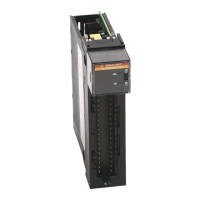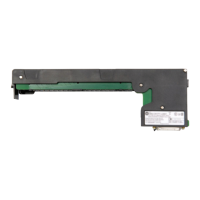174 Rockwell Automation Publication 1756-UM540E-EN-P - December 2017
Chapter 9 Troubleshoot Your Module
If the previously listed tasks fail to resolve your issue with incorrect RTD readings
on your module, use the following table.
Table 25 - Troubleshoot Incorrect RTD Readings
Possible Cause of Incorrect
Reading
Description Recommended Action
Wire Off When using a 3-wire RTD
device and any of the following:
• One wire is disconnected
from any of the channel’s
terminals.
• Wires are disconnected from
any combination of
terminals:
– IN_x(+)/A
– IN_x(-)/B
– IN_x/RTD C
• All of the wires are
disconnected from the
channel.
The following occurs:
• Input data for the channel
changes to the highest scaled
temperature value associated
with the selected sensor type.
• The I.Ch[x].Overrange tag is
set to 1.
x represents the channel
number.
• Check the wiring, terminations, and for an open wire.
• Make sure the length of the RTD cable is within module
specifications.
Wire length that is too long has a higher impedance, and can be
interpreted as an open circuit.
When using a 4-wire RTD
device and any of the following:
• A wire is disconnected from
only terminal IN_x(-)/B.
• Wires are disconnected from
any combination of the
channel’s terminals, that is:
– IN_x(+)/A
– IN_x(-)/B
– IN_x/RTD C
– IN_x/RTD D
IMPORTANT: There is one
combination exception that
does not apply.
A wire off condition is not
detected when wires are
simultaneously disconnected
from only IN_x/RTD C and
IN_x/RTD D terminals.
• All wires are disconnected
from the module.
If bullet 1, the following occurs:
• Input data for the channel
changes to the lowest scaled
temperature value associated
with the selected sensor type.
• The I.Ch[x].Underrange tag is
set to 1.
x represents the channel
number.
If bullets 2 or 3, the following
occurs:
• I
n
put data for the channel
changes to the highest scaled
temperature value associated
with the selected sensor type.
• The I.Ch[x].Overrange tag is
set to 1.
x represents the channel
number.
Electrical noise Erratic readings, that is, data fluctuating more than is typical, are a
cause of noise. An oscilloscope shows the magnitude of noise.
• Disconnect all but one RTD to see if channels are affecting each
other, that is, there is bleed-over.
• Eliminate or suppress the effect of noise.
Employ hardware or software filters provided by the 1756-IRT8I
module, such as the Notch Filter.
DC signal on top of the
thermocouple signal
Offset readings can be caused by a DC signal riding on top of the
thermocouple signal. An oscilloscope shows the magnitude of the
offset.
Disconnect all but one RTD to see if channels are affecting each other,
that is, there is bleed-over.
Module is in calibration mode Incorrect readings can be a result of the module being calibrated
when the reading occurs.
Make sure the module is not in calibration mode.
This symptom is module dependent, but in general, specific bits have
to be turned on to enable calibration.

